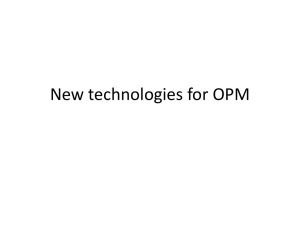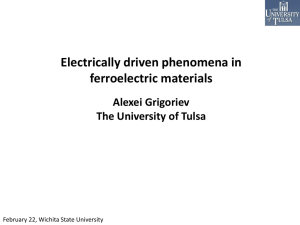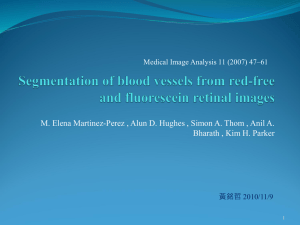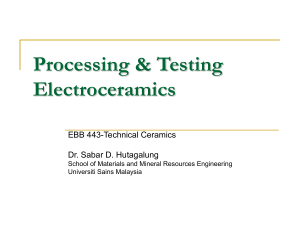Phase field model
advertisement
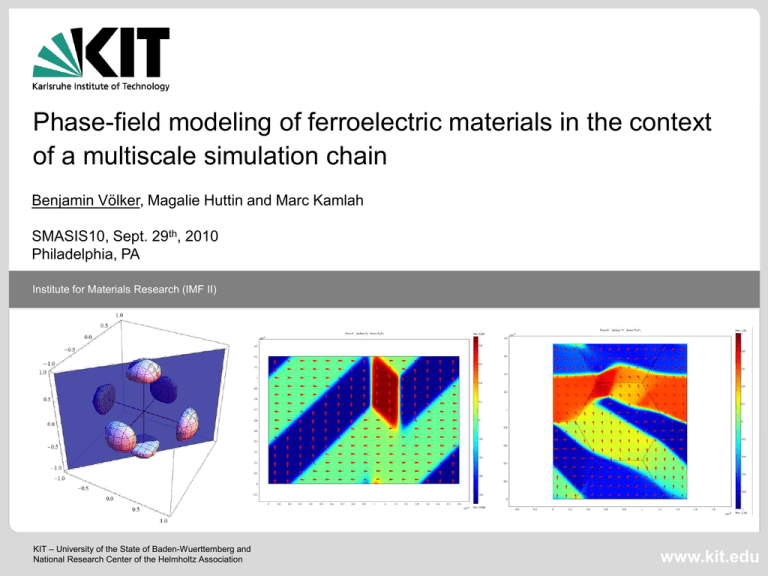
Phase-field modeling of ferroelectric materials in the context of a multiscale simulation chain Benjamin Völker, Magalie Huttin and Marc Kamlah SMASIS10, Sept. 29th, 2010 Philadelphia, PA Institute for Materials Research (IMF II) KIT – University of the State of Baden-Wuerttemberg and National Research Center of the Helmholtz Association www.kit.edu Motivation: virtual material development for ferroelectrics Micromechanical modeling (RB/SAG) need for multiscale-approach BMBF-Project COMFEM: micro-scale: grain structure Phase field modeling (KIT) meso-scale: ferroelectric domain patterns ab-initio / DFT / SMP (FhG-IWM) nano-scale: distorted unit cell 2 Computer based multiscale modeling for virtual development of polycrystalline ferroelectric materials (esp. PZT) Project partners: - Fraunhofer IWM Freiburg (FhG-IWM) - Robert Bosch GmbH (RB) - Siemens AG (SAG) - PI Ceramic AG (PIC) - CeramTec AG (CT) - TU Hamburg-Harburg (TUHH) Our aim: development of two interfaces in simulation chain B. Völker, M. Huttin and M. Kamlah – Phase-field modeling for ferroelectric materials in the context of a multiscale simulation chain SMASIS 2010 Thermodynamically motivated phase-field theory Aim: calculation of ferroelectric domain patterns on meso-scale Helmholtz free energy function contains all crystallographic and boundary information state variables: partial derivatives with respect to natural variables temporal and spatial evolution of polarization (order parameter): time-dependent Ginzburg-Landau-equation domain switching caused by minimization of free energy 3 B. Völker, M. Huttin and M. Kamlah – Phase-field modeling for ferroelectric materials in the context of a multiscale simulation chain SMASIS 2010 Formulation of the phase-field model’s free energy 6th order free energy Main parts of energy function: • • • • • 4 gradient term Landau energy electromechanical coupling term elastic energy term electric field energy B. Völker, M. Huttin and M. Kamlah – Phase-field modeling for ferroelectric materials in the context of a multiscale simulation chain SMASIS 2010 Adjustment of 6th order free energy Interface ab-initio / phase field modeling: Adjustment of parameters ab-initio: (input) piezoelectric coefficients dielectric permittivity elastic stiffness spontaneous strain spontaneous polarization domain wall energy (90°/180°) domain wall thickness (90°/180°) dijk κij Cijkl εS PS γ90/180 ξ90/180 Ginzburg-Landau-theory: 15 parameters (6th order) αijklmn qijkl cijkl Gijklj • adjustment method has been developed • applied to PTO and PZT B. Völker, P. Marton, C. Elsässer, M. Kamlah: “Multiscale Modeling of ferroelectric materials: a transition from the atomic level to phase-field modeling”. Continuum Mechanics and Thermodynamics, submitted on Sept. 3rd, 2010 5 B. Völker, M. Huttin and M. Kamlah – Phase-field modeling for ferroelectric materials in the context of a multiscale simulation chain SMASIS 2010 Adjustment of 6th order free energy: Results for PTO and PZT DFT SMP atomistic input: DFT: density functional theory SMP: shell-model potential (P. Marton and C. Elsässer, IWM Freiburg) 6 generally good agreement, but: • not enough degrees of freedom for piezoelectric coefficients • only cubic elastic behavior taken into account B. Völker, M. Huttin and M. Kamlah – Phase-field modeling for ferroelectric materials in the context of a multiscale simulation chain SMASIS 2010 Formulation of the phase-field model’s free energy 6th order free energy additional terms [Su,Landis2007], for BaTiO3 Main parts of energy function: • gradient term • Landau energy • electromechanical coupling term • elastic energy term • electric field energy benefit of additional terms: more degrees of freedom for adjustment process: f-term: tetragonal elastic behavior g-term: independent adjustment of dijk Y. Su, C. M. Landis: “Continuum thermodynamics of ferroelectric domain evolution: Theory, finite element implementation, and application to domain wall pinning”. Journal of the Mechanics and Physics of Solids, 55 (2007), 280–305 7 B. Völker, M. Huttin and M. Kamlah – Phase-field modeling for ferroelectric materials in the context of a multiscale simulation chain SMASIS 2010 Improvement of adjustment process – additional energy terms Additional elastic energy term From [Su,Landis2007], for BaTiO3 Idea: elastic stiffness depends on polarization P=0: cubic elastic properties Ccub can be adjusted independently P=P0 : tetragonal elastic properties Ctetr works fine for BaTiO3, but problematic for DFT predictions of PbTiO3 and PZT no f-term 8 f-term, Ccub<Ctetr B. Völker, M. Huttin and M. Kamlah – Phase-field modeling for ferroelectric materials in the context of a multiscale simulation chain SMASIS 2010 f-term, Ccub>Ctetr Improvement of adjustment process – additional energy terms Suggestion: additional elastic energy term h-term necessary, when Ccub>Ctetr h-term: ensures elastic stiffness to remain positive one possibility: C(P) has minimum at P=P0 f-term, Ccub>Ctetr 9 f-term + h-term Ccub>Ctetr B. Völker, M. Huttin and M. Kamlah – Phase-field modeling for ferroelectric materials in the context of a multiscale simulation chain SMASIS 2010 Extended free energy [Su,Landis2007] Additional free energy terms: 10 Landau energy: P8-term Pi4Pj4-term 180° domain wall adjustment 90° domain wall adjustment Elastic energy: f-term h-term tetragonal elastic behavior necessary if Ccub>Ctetr coupling energy: g-term piezoelectric coefficients B. Völker, M. Huttin and M. Kamlah – Phase-field modeling for ferroelectric materials in the context of a multiscale simulation chain SMASIS 2010 Results: Adjustment of 8th order free energy + additional terms PZT: complete agreement between atomistic input and adjusted phase-field model PTO: only 180° domain wall energy too high, otherwise complete agreement 11 B. Völker, M. Huttin and M. Kamlah – Phase-field modeling for ferroelectric materials in the context of a multiscale simulation chain SMASIS 2010 Second interface: phase-field - micromechanics Input for micromechanical model: multiscale modeling ab-initio and atomistic (FhG-IWM) phase field modeling (KIT) micromechanical modeling (RB,SAG) - domain effective material parameters: - irreversible switching behavior FE-Implementation: degrees of freedom per node: [Su,Landis2007] independent variables Weak form: subdomain (volume) terms boundary terms direct implementation of weak form in COMSOL Multiphysics Aim: investigation of typical bulk domain structures 12 B. Völker, M. Huttin and M. Kamlah – Phase-field modeling for ferroelectric materials in the context of a multiscale simulation chain SMASIS 2010 How to obtain typical domain configurations? Simulation of a whole grain (Ø~µm): not possible! real domain structure: no knowledge about pinning, boundaries, … FE-model: - 2D - DOF: Px, Py, Pz, ux, uy, uz,Φ - x/y: periodic boundary conditions (Pi, ui, Φ) - z-direction: plain strain - reasonable mesh density: 5-6 nodes / nm 1) bulk behavior: periodic boundary conditions required 2) stabilize configuration: apply global strain investigate “typical” domain structures: - monodomain - ideal 90° domain stack - defect-free bulk domain structures - influence of charge defects and grain boundaries y z 13 B. Völker, M. Huttin and M. Kamlah – Phase-field modeling for ferroelectric materials in the context of a multiscale simulation chain SMASIS 2010 x Example 1: Investigation of 90° domain stacks From PFM-experiments: typical domain width ~100-200 nm [Fernandéz/Schneider,TUHH] Example: 90°- stack, electrical loading (Y-direction) PZT Zr/Ti 50/50 Nb 1 mol% Domain wall (DW): 1) artificially completely fixed 2) free slope: domain effective dielectric permittivity 0.014 10 µm fixed DW free DW 0.012 1.5 µm 0.010 50 nm Dy [C/m²] Phase field model: 90° domain stack 0.008 domain wall free: intrinsic and extrinsic 0.006 0.004 0.002 domain wall fixed: intrinsic 200 nm -Pxspont y 0 - 2D, ~450k degrees of freedom - periodic boundary conditions x - electrical / mechanical loading Pxspont Px 0.000 0 1000000 2000000 3000000 4000000 applied electric field Ey [V/m] intrinsic/ extrinsic piezoelectric effect (reversible) DW motion small signal behavior: reversible domain wall motion identified as governing process 14 B. Völker, M. Huttin and M. Kamlah – Phase-field modeling for ferroelectric materials in the context of a multiscale simulation chain SMASIS 2010 Example 2: Influence of grain boundaries Motivation: Influence of polarization orientation mismatch at grain boundaries on domain structure 30 nm unit cell: example: PTO 30° 45° 35 nm 45° 15° a0 0° 0° 30° simple model: example: • → • 15 allows for different polarization directions → 4 “grains” rotated between 0° and 45°around (001)-axis a0 = 10nm can be continued periodically B. Völker, M. Huttin and M. Kamlah – Phase-field modeling for ferroelectric materials in the context of a multiscale simulation chain SMASIS 2010 Reversible DW motion and irreversible switching 4 3 Domain fraction (%) 20 16 y 0 1 3 6 1 2 12 8 4 0.0 z 5 2 x 0.1 0.2 0.3 electric loading in y-direction: Ey/EC,180 4 5 6 determination of small signal parameters & domain fraction evolution for micromechanical model 16 B. Völker, M. Huttin and M. Kamlah – Phase-field modeling for ferroelectric materials in the context of a multiscale simulation chain SMASIS 2010 Summary & Outlook multiscale modeling ab-initio and atomistic (FhG-IWM) phase-field modeling (KIT) Interface ab-initio / phase-field Interface phase-field / micromechanics new approach for adjustment of energy function parameters solely based on results of atomistic calculations FE-implementation in COMSOL Multiphysics, including periodic boundary conditions additional energy term introduced enabling tetragonal elastic behavior in PTO and PZT successfully applied to PTO and PZT 17 micromechanical modeling (RB,SAG) intensive investigation of typical bulk domain structures computation of small signal parameters, can be transferred to micromechanical model B. Völker, M. Huttin and M. Kamlah – Phase-field modeling for ferroelectric materials in the context of a multiscale simulation chain SMASIS 2010 Thanks for your attention! Literature: [Su,Landis2007] [Devonshire1954] [Cao,Cross1991] 18 Yu Su, Chad M. Landis: “Continuum thermodynamics of ferroelectric domain evolution: Theory, finite element implementation, and application to domain wall pinning”. Journal of the Mechanics and Physics of Solids, 55 (2007), 280–305 A.F. Devonshire: “Theory of Barium Titanate”. Philos. Mag. 40, 1040-1079 (1949) W. Cao, L.E. Cross: “ Theory of tetragonal twin structures in ferroelectric perovskites with a first-order phase transition”. Physical Review B, 44(1), 5-12 (1991) B. Völker, M. Huttin and M. Kamlah – Phase-field modeling for ferroelectric materials in the context of a multiscale simulation chain SMASIS 2010


